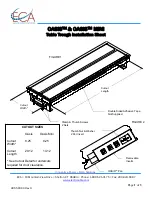
ECG Monitoring Mode
You can use the AED Pro unit for short-term monitoring of the patient’s electrocardiogram
(ECG). The AED Pro unit monitors lead II only.
In ECG monitoring mode, the screen shows the shock count, elapsed time, mode
(MONITOR), heart rate, heartbeat symbol, ECG size, ECG rhythm, and text messages.
WARNING! An implanted pacemaker might cause the heart rate meter or ECG rhythm
analysis to count the pacemaker rate during incidents of cardiac arrest or other
arrhythmia.
Carefully observe pacemaker patients. Check the patient’s pulse; do not rely solely on the
heart rate meter. Patient history and physical examination are important in determining
the presence of an implanted pacemaker.
ECG Electrode Placement
Before applying ECG electrodes, be sure to
• Remove all clothing covering the patient’s chest.
• Clip or shave any excessive hair to ensure proper adhesion of the electrodes.
• Use alcohol to wash away any oil or dirt at the electrode site.
• Dry any moisture at the electrode site.
Some skin abrasion is necessary to remove the top layer of dead skin cells and expose
moist living cells for better electrical contact. Proper skin preparation reduces baseline
wander and noise and provides a noise-free signal more quickly after electrode
application.
Place ECG electrodes on the patient’s chest as follows:-
R (red)
Patient’s right midclavicular line, directly below clavicle.
L (yellow)
Patient’s left midclavicular line, directly below clavicle.
F (green)
Between sixth and seventh intercostal space on the
patient’s left midclavicular line.






































